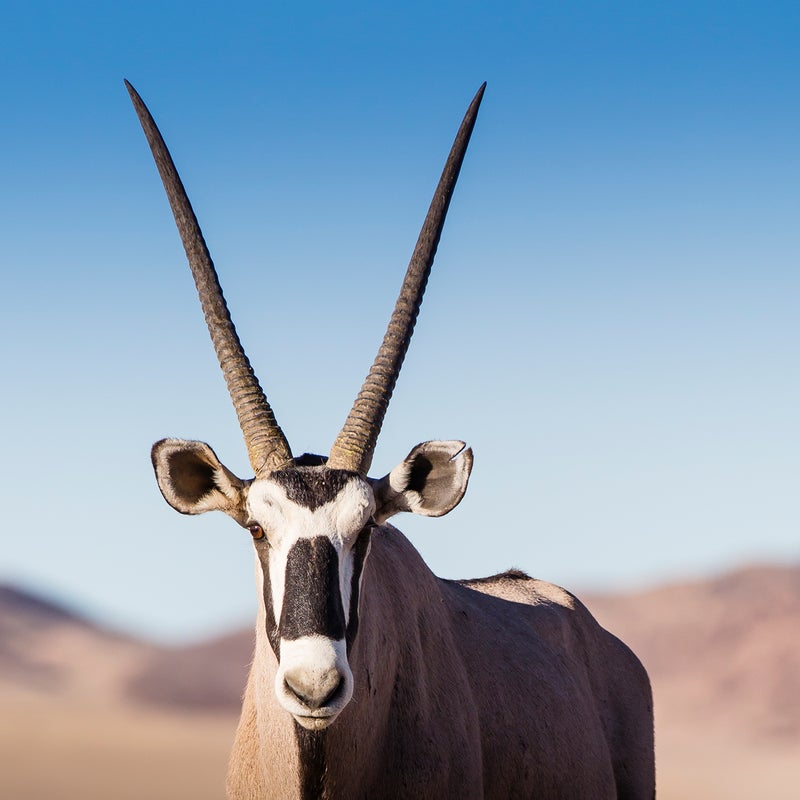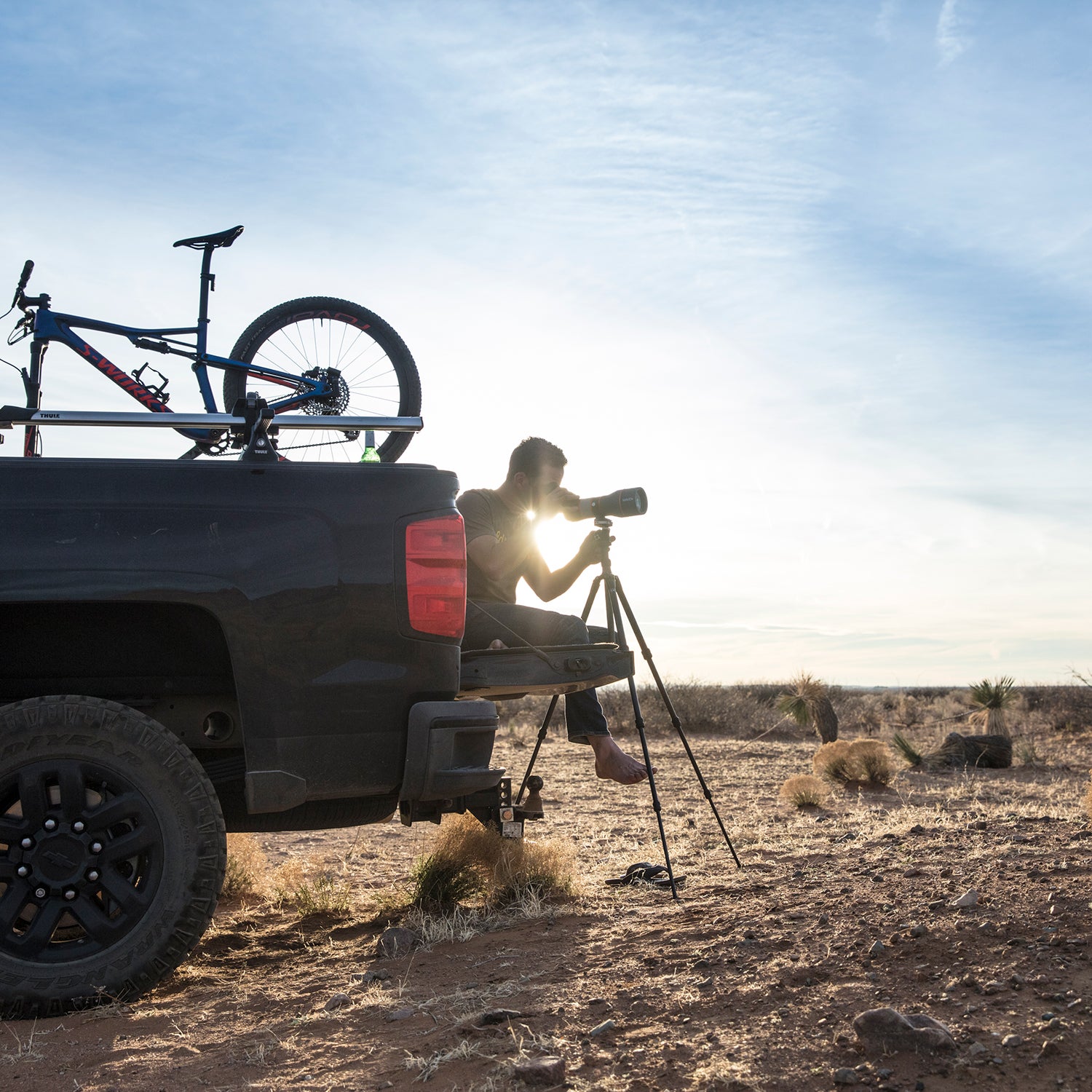When Jen spotted our first ibex, a nanny goat clinging to the shade on the west side of a slickrock arroyo, the creature was 800 yards out and so well camouflaged that, even with JenÔÇÖs description, it took me ten minutes to find her. As we watched, more and more animals emerged from the craggy hillside, like shapes on those Magic Eye 3D puzzlers. We counted a herd of at least a dozen ibex. After GPSing their location, we eased into the arroyoÔÇöand out of their sightÔÇöand began picking our way toward them on foot for a closer view.
WeÔÇÖd come to New MexicoÔÇÖs Florida Mountains (pronounced flow-REE-duh), a few miles north and west of the Mexican state of Chihuahua, in search of these Persian ibex. This 15-mile-long chain of dry mountains on the border is the only place in the country where these animals roam free. ║┌┴¤│ď╣¤═° the United States, youÔÇÖd have to go to ranges between Turkey and Afghanistan to see them.
The Persian ibex is just one in a trio of exotic game species that you can seek out and track in New Mexico. Farther east, in the Tularosa Basin and beyond, mask-faced African antelope called oryx range the Chihuahuan Desert. And in the southeast corner of the state, North African Barbary sheep have taken hold and begun to spread northward through the mountains. If you factor in less-exotic species, such as elk, mule deer, and sandhill cranes, the Land of Enchantment turns out to be one hell of a destination for a domestic safari.

Two of the exotics, ibex and oryx, trace back to Frank C. Hibben, an avid hunter and chairman of the New Mexico Game Commission in the late 1940s and ÔÇÖ50s who advocated importing big-game species to bolster the stateÔÇÖs hunting opportunities. Starting in 1969, the New Mexico Department of Game and Fish (NMDGF) began releasing 93 oryx onto White Sands Missile Range with the idea they would take hold and maintain a small population of around 600 head. That same year, 15 ibex, of an eventual total release of 73, were introduced in the Floridas.
The population of Barbary sheep began their tenure in New Mexico as by an eccentric rancher named Joe McKnight. They were then stocked in the 1950s by the NMDGF. In all three cases, the creatures flourished beyond expectations, partly due to a dearth of natural predators, which has created large populations (around 4,000 oryx and 600 ibex) that are managed for hunting. Barbary sheep are now so profuse in the southeast mountains that they arenÔÇÖt even surveyed.
Just because there are a lot of these animals doesnÔÇÖt make them easy to find. For one, you have to work around hunting season, roughly November to March, since you canÔÇÖt wear blaze orange if youÔÇÖre tracking wild animals. But more important, all three of these species favor harsh, brutal desert and scratchy, rugged mountains, which makes tracking and finding them a challenge. Not unlike chasing elk or deer, you have to start well before sunrise or be willing to stay out past sunset, move quickly yet stealthily in harsh country, and have a lot of patience. Even when you put yourself in the right spots, you can expect to spend long hours glassing the surrounding mountains with your binoculars, as we did in Barbary country, before the animals materialize.
Having trackedÔÇöand foundÔÇöbarbs, oryx, elk, and deer over the years in New Mexico, this spring, as we were traipsing around the desert southwest, we decided weÔÇÖd try our hand at ibex, which is how we ended up south of Deming. ThereÔÇÖs nice camping at , on the northeast flank of the Floridas, as well as fairly reliable ibex viewing in nearby Spring Canyon. But we wanted a more exploratory experience, so we took advantage of the public lands encircling the range, which offered up plenty of quiet boondocking opportunities for Artemis the Airstream, and spent much of our days in the southern part of the sky island.

The mountains here are steep, desiccated, and flat-out savage. Though we spent the better part of our first day trundling up and down 55-degree scree slopes, through grabby stands of Gambel oak, and over volcanic outcrops, we saw absolutely zero animals. ThatÔÇÖs why our day two sighting up the rocky arroyo was such a thrill. Ibex are reclusive and notoriously difficult to find; their eyesight is around seven-power compared to humans. Even seeing them briefly at such a distance felt like a win. And though wild goats may not sound like an exotic sighting, billies (the males) weigh up to 200 pounds and sport scimitar-like horns that can grow up to five feet long. They cut an imposing figure, especially when you see them scampering across cliffs as easily as weÔÇÖd traverse a sidewalk. By the time weÔÇÖd snuck into a better position, our herd was already moving off, though we got another short glimpse of two big males with their dramatic horns silhouetted against the sky as they crested the ridge above us.
We could have gone home happy, but we headed out again a few mornings laterÔÇöand good thing. At dawn, Jen spied another herd. The ibex were far off again, around 750 yards, but this time we had better cover and were able to move into position. We eventually set up in some rocks on a ridge above a rocky defile, where we watched the animals graze across the far slope.
Having grown up in Nigeria┬áand gone on countless safaris, I can say that our ibex experience was just as rewarding, if not more so, than any game drive. The simple act of negotiating big, difficult country is part of the appeal. And itÔÇÖs satisfying to find wildlife on your own and move stealthily enough that you go undetected. For a short time, you become part of the environment rather than just a clumsy human looking in.
For half an hour, we watched the herd, which had seven or eight big billies, until it trickled around the side of a cliff and out of view. Then, in the tangerine light of dawn, we pulled out some sausage, cheese, and a flask of coffee and savored a simple breakfast in big country.
If You Go
Ibex, like most big game, are most active at dawn and dusk; begin well before sunrise and plan to be out past dark. Look for signs, including hoofprints and droppings, which can direct your search. As a rule, though, the goats favor the highest, rockiest, most gnarly terrain available for safety from predators, so plan to do a lot of vertical. (For the quickest sightings, try the state park at Spring Canyon, where the animals often congregate.)
The best tactic is to hit high ground very early, take cover in rock outcroppings or beneath a tree or bush, and then get out your binoculars. A set with high-quality glass, such as the Maven B1, is key to success, and a spotting scope like the can help push your glassing range from 700 or 800 yards to double or triple. Divide the hillsides into a grid and study them carefully. Movement will be the best giveaway, but also look for body shapes and, especially, horns, which can look out of place. Most of all, be patient. You can spend hours looking with no success, and then suddenly animals could appear. If you get tired of sitting, hike up to another high point to change your vantage and start again. These rules mostly hold true for all game animals in New Mexico, including oryx, Barbary sheep, elk, and deer.


